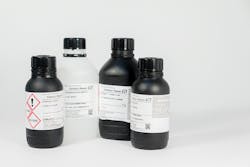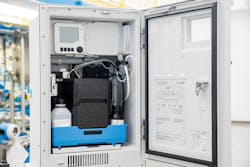How to Apply and Maintain a Photometric/Colorimetric Analyzer
By Steve Smith
As state environmental agencies and the U.S. Environmental Protection Agency (EPA) require dischargers to reduce the amount of nutrients in their effluent, permitted levels for ammonium and orthophosphate are becoming increasingly tight. As a result, water resource recovery (WRR) plants must monitor for these nutrients.
Photometric/colorimetric analyzers can be used to monitor ammonium and orthophosphate and typically provide lab-quality results that are EPA compliant. Keys to the success of a colorimetric analyzer installation are proper application and maintenance of the instrument.
Functionally, an analyzer receives a sample extracted from the process and combines it with reagents that react with the ammonium or orthophosphate, resulting in a specific sample color. In addition to the colorimetric reagents and calibration standard, these instruments also typically employ a solution to periodically clean the system and photometer.
Color intensity is directly proportional to ammonium or orthophosphate levels. Color intensity is measured photometrically, and the ammonium or orthophosphate level is determined using a calibration curve, based on a standard calibration solution.
Colorimetric analyzers require reagents.
Analyzer Chemical Management
Analyzers consume reagent chemicals, and their operational costs rise and fall with reagent consumption. Each internal cleaning and calibration cycle also consumes chemicals. In some analyzers, the rate of cleaner consumption increases along with water hardness, adding to the cost of operation.
The more reagent consumed with each analysis, the higher the operating cost of the analyzer. Some systems offer internal reagent cooling systems to help extend the life of reagents. Newer analyzer designs, with more precise reagent dosing systems, are capable of reducing chemical costs to significantly less than $200 a month. The analyzer should also track reagent use and provide indication when it’s time to replace it.
Component Wear and Service
Some analyzers need extensive part replacement using an array of tools. Newer analyzers are designed to significantly reduce the number of parts requiring service, virtually eliminate the need for tools, and dramatically reduce the time required to perform routine maintenance. All these features help keep the cost of ownership low, minimize analyzer downtime, and reduce requirements for specialized labor.
Endress+Hauser CA80PH orthophosphate analyzer.
Control system integration
Today, a range of output options exist to bring data from photometric/colorimetric analyzers to a control system. In addition to the traditional analog (4-20 mA) outputs, systems are available with a range of fieldbus digital communications, such as Profibus, Modbus or EtherNet/IP. Additionally, some systems provide the ability to integrate other sensor measurements within the analyzer, expanding the functionality of the analyzer and reducing the capital costs for additional measurement values.
Summary
Photometric/colorimetric analyzers provide valuable information for the efficient operation of a WRR plant. With careful consideration of several key attributes, plant operators can reliably obtain years of high-quality data at a reasonable cost. WW
About the Author: Steven Smith is the senior analytical product marketing manager for Endress+Hauser USA.
Endress+Hauser is exhibiting at ACE19, booth 1739. Learn more at www.us.endress.com.
Circle No. 286 on Reader Service Card


